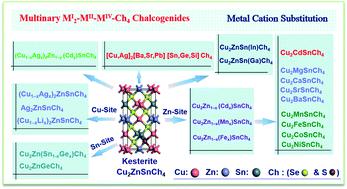当前位置:
X-MOL 学术
›
J. Mater. Chem. A
›
论文详情
Our official English website, www.x-mol.net, welcomes your feedback! (Note: you will need to create a separate account there.)
Defect suppression in multinary chalcogenide photovoltaic materials derived from kesterite: progress and outlook
Journal of Materials Chemistry A ( IF 11.9 ) Pub Date : 2020-11-03 , DOI: 10.1039/d0ta08202c Qingwen Tian 1, 2, 3, 4, 5 , Shengzhong (Frank) Liu 1, 2, 3, 4, 5
Journal of Materials Chemistry A ( IF 11.9 ) Pub Date : 2020-11-03 , DOI: 10.1039/d0ta08202c Qingwen Tian 1, 2, 3, 4, 5 , Shengzhong (Frank) Liu 1, 2, 3, 4, 5
Affiliation

|
The performance of many emerging multinary chalcogenides for photovoltaic (PV) applications has been considerably inferior to the Shockley–Queisser limit, and one of the main reasons for this is the existence of various detrimental deep-level defects and defect clusters. Among them, the development of kesterite-based Cu2ZnSn(Sx,Se1−x)4 (CZTCh) solar cells is currently hindered by a large open-circuit voltage deficit (Voc,def). Much of this Voc,def could be ascribed to the abundant cation disorder and defect clusters in the CZTSSe absorber layer, which is the origin of band-tail states caused by electrostatic potential fluctuations. To deal with the above intractable issues encountered in kesterite-like materials, a partial or complete cation substitution strategy offers a viable pathway to alter the characteristics of such deleterious defects and defects clusters, namely, (i) partial cation substitution can introduce ionic-size mismatch for alleviating antisite disorder and/or detrimental defect clusters to mitigate a large Voc,def and (ii) complete cation substitution can be expected to eliminate notorious band-tail states. This can foster the development/exploration of many emerging multinary chalcogenides beyond the kesterite-based CZTSSe for PV applications. In this review, we summarize the above recent efforts and attempts in both state-of-the-art experimental studies and gaining new theoretical insights to alleviate the problems associated with CZTSSe, as well as learn a lesson for applying to other promising chalcogenide PV materials. In addition, the record efficiencies for cation-substituted kesterite and related  chalcogenides PV devices reported till date have been summarized in this review. Finally, a summary and outlook are provided on the current research trends in relation to improving kesterite-based devices, as well as the exploration of related chalcogenides PV materials.
chalcogenides PV devices reported till date have been summarized in this review. Finally, a summary and outlook are provided on the current research trends in relation to improving kesterite-based devices, as well as the exploration of related chalcogenides PV materials.
中文翻译:

抑制从钾长石衍生的硫族化物光伏材料中的缺陷:进展和展望
许多新兴的用于光伏(PV)应用的多元硫族化物的性能远不如Shockley-Queisser极限,其主要原因之一是存在各种有害的深层缺陷和缺陷簇。其中,目前,由于大的开路电压赤字(V oc,def),阻碍了基于锂沸石的Cu 2 ZnSn(S x,Se 1- x)4(CZTCh)太阳能电池的发展。这个V oc,def的大部分可以归因于CZTSSe吸收层中大量的阳离子无序和缺陷簇,这是由静电势波动引起的带尾态的起源。为了解决在类似镁橄榄石型材料中遇到的上述棘手问题,部分或完全阳离子取代策略提供了一条可行的途径来改变此类有害缺陷和缺陷簇的特性,即(i)部分阳离子取代会引入离子尺寸失配以缓解反位错和/或有害缺陷簇以减轻大V oc,def(ii)完全阳离子取代有望消除臭名昭著的带尾态。除了可以用于光伏应用的基于硅藻土的CZTSSe之外,这还可以促进许多新兴的多元硫族化物的开发/探索。在这篇综述中,我们总结了上述最新的努力和尝试,并进行了最新的实验研究,并获得了新的理论见解,以缓解与CZTSSe相关的问题,并学习了将其应用于其他有前景的硫族化物光伏材料的经验教训。此外,阳离子取代的钾长石及其相关产品的效率创纪录 迄今为止,已报道了迄今报道的硫属硫化物光伏器件。最后,总结和展望了与改进基于硅藻土的装置以及有关硫属硫化物光伏材料的探索有关的当前研究趋势。
迄今为止,已报道了迄今报道的硫属硫化物光伏器件。最后,总结和展望了与改进基于硅藻土的装置以及有关硫属硫化物光伏材料的探索有关的当前研究趋势。
更新日期:2020-11-21
 chalcogenides PV devices reported till date have been summarized in this review. Finally, a summary and outlook are provided on the current research trends in relation to improving kesterite-based devices, as well as the exploration of related chalcogenides PV materials.
chalcogenides PV devices reported till date have been summarized in this review. Finally, a summary and outlook are provided on the current research trends in relation to improving kesterite-based devices, as well as the exploration of related chalcogenides PV materials.
中文翻译:

抑制从钾长石衍生的硫族化物光伏材料中的缺陷:进展和展望
许多新兴的用于光伏(PV)应用的多元硫族化物的性能远不如Shockley-Queisser极限,其主要原因之一是存在各种有害的深层缺陷和缺陷簇。其中,目前,由于大的开路电压赤字(V oc,def),阻碍了基于锂沸石的Cu 2 ZnSn(S x,Se 1- x)4(CZTCh)太阳能电池的发展。这个V oc,def的大部分可以归因于CZTSSe吸收层中大量的阳离子无序和缺陷簇,这是由静电势波动引起的带尾态的起源。为了解决在类似镁橄榄石型材料中遇到的上述棘手问题,部分或完全阳离子取代策略提供了一条可行的途径来改变此类有害缺陷和缺陷簇的特性,即(i)部分阳离子取代会引入离子尺寸失配以缓解反位错和/或有害缺陷簇以减轻大V oc,def(ii)完全阳离子取代有望消除臭名昭著的带尾态。除了可以用于光伏应用的基于硅藻土的CZTSSe之外,这还可以促进许多新兴的多元硫族化物的开发/探索。在这篇综述中,我们总结了上述最新的努力和尝试,并进行了最新的实验研究,并获得了新的理论见解,以缓解与CZTSSe相关的问题,并学习了将其应用于其他有前景的硫族化物光伏材料的经验教训。此外,阳离子取代的钾长石及其相关产品的效率创纪录
 迄今为止,已报道了迄今报道的硫属硫化物光伏器件。最后,总结和展望了与改进基于硅藻土的装置以及有关硫属硫化物光伏材料的探索有关的当前研究趋势。
迄今为止,已报道了迄今报道的硫属硫化物光伏器件。最后,总结和展望了与改进基于硅藻土的装置以及有关硫属硫化物光伏材料的探索有关的当前研究趋势。


























 京公网安备 11010802027423号
京公网安备 11010802027423号